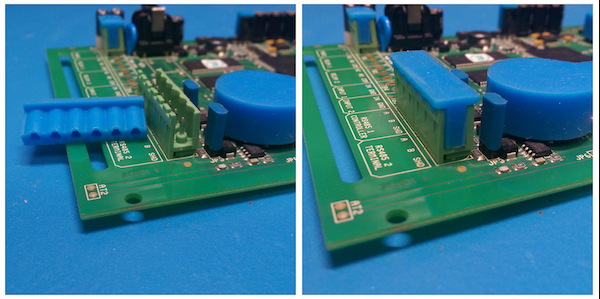Masking Boots for Conformal Coating
Posted by Sean Horn
Friday, March 9, 2018 7:33
@ 7:33 AM
With proper equipment and professional expertise, liquid conformal coatings and vapor-applied parylene readily provide printed circuit boards (PCBs) and similar electronics a durable overlay of protective, insulative film; parylene’s CVD processes ensure the coating actually penetrates the substrate surface, generating further device security.
However, the very insulative properties that help conformal coatings safeguard PCBs will negate the performance of such critical electrical components as capacitors, connectors, diodes, resistors, or transistors, blocking their ability to transmit or receive electrical signals. Protecting PCB components from the encapsulating properties of conformal materials, which would suspend their operational capabilities is imperative. These keep-out areas require masking prior to initiating the coating process, to assure designated PCB components are NOT covered;
Also called caps or plugs, custom reusable boots surpass masking tapes or dots for assignments demanding an explicit volume of repeat-masking. Efficiently covering PCB’s electronic components, masking boots ensure reliable performance, preventing coating seepage onto and within keep-out regions. In addition, boots don’t leak as frequently as tapes or dots, eliminating the need for masking (and coating) re-work, adding significantly to their return on investment (RoI). They are also better adapted to accommodating the masking needs of a wider range of component shapes and sizes.
Other masking solutions often necessitate costly, labor-intensive and time-consuming processes, limiting RoI while delaying project completion. Fastening over often large areas of the PCB, boots provide a labor-saving alternative for:
- masking components prior to coating application and
- demasking, after coatings have dried.
Resulting reduction in both masking and demasking time/labor shaves as much as 75% off operating costs. Moreover, reusable boots do not require constant replacement (repurchase); some can be used 200(+) times before replacement is necessary! The initial investment constructing custom-made boots is rapidly recovered through their continual reuse, rather than the ongoing replacement required for tapes and dots.

Different Styles of Masking Boots
Masking materials come in various forms; among the most prominent are
- paper/polyimide/polyester masking tapes/dots/contact pads,
- polymeric covers/plugs that peel-off accumulated coating following application, and
- custom/reusable masking boots.
Effective masking requires coordinating masking types and materials with the specific masking project. Tapes/dots/contact pads are frequently the choice for many projects where less expansive surface areas require coverage; cover/plugs are easy to use for specified masking purposes. Masking boots are recommended for larger projects, especially those characterized by irregular board topographies.
Designed to flexibly cover larger PCB components, recyclable masking boots readily accommodate projects requiring repeat masking of high-volume production. The most common boot materials are silicone rubber and similar low- hardness elastomers, which offer:
- enhanced sealing properties compared to other substances, and
- the supple strength required to resist repeated applications of conformal coating.
Electrostatic discharge (ESD) resistant boots are always available, generally at higher cost. Custom-boot sizes and colors are adaptable, dependent on coating project specifications; boots’ material composition varies to encompass:
- the component’s function, shape and size,
- its location on the PCB assembly,
- the kind of conformal coating covering the assembly, and
- the coating material’s application methodological requirements.
Once these factors have been determined, criteria for determining the assignment’s proper boot configuration are better defined
Masking boots have two basic format styles: A and C type Cups:
- Used to shield vertical connectors and components, A Cups represent the simplest style, often taking the form of masking covers for d-type and molex connectors.
- Typically more complex in design, C Cups mask horizontal connectors, attaching to and encasing the component from both sides; their most prominent advantage is customization, housing asymmetrical or multifaceted assembly edges and surfaces.
- A and C Cup boots both generate dependable security for the static-sensitive components they cover.
- Customizable, these boot styles can be tailored to the precise topographical requirements of PCB surfaces, regardless of components’ size/shape, or existing irregularities — depressions or indentations — along component surfaces; the result is exceptional production versatility.
- At the same, both A and C cups are available in standardized versions, according to such component-specific factors as the assembly’s size/shape and differences in external/internal dimensions.
While boots are not recommended for dip applications, they are very efficient for spray treatments and other liquid-application procedures; production turn-around is fast and reliable. The same is true for most parylene CVD processes. However, A-type molex boots applied for spray-shielding purposes may begin to deteriorate over time, causing coating-seepage into the component. Boot replacement is then necessary. These factors largely determine assignment boot type, whether standard or customized.
Reusable boots provide a strong, cost-effective alternative to masking tape or dots. Depending on your conformal coating needs, Diamond-MT offers clients a variety of standard and custom boot solutions. We have a wide range of standard boots in stock, to be matched to your project specifications. Our design services can also develop a custom masking solution to accommodate your specialized PCB components. Contact us today to request a quote.
To learn more about conformal coating masking, download our whitepaper:
Conformal Coating Masking Whitepaper
Comments
Homepage 4/17/2020. 10:17:10 AM
... [Trackback] [...] Informations on that Topic: blog.paryleneconformalcoating.com/whats-the-difference-between-potting-and-conformal-coating/ [...]

londondrugscanada.bigcartel.comlondon-drugs 4/17/2020. 10:17:10 AM
cialis uk https://londondrugscanada.bigcartel.com/london-drugs This is nicely expressed. !